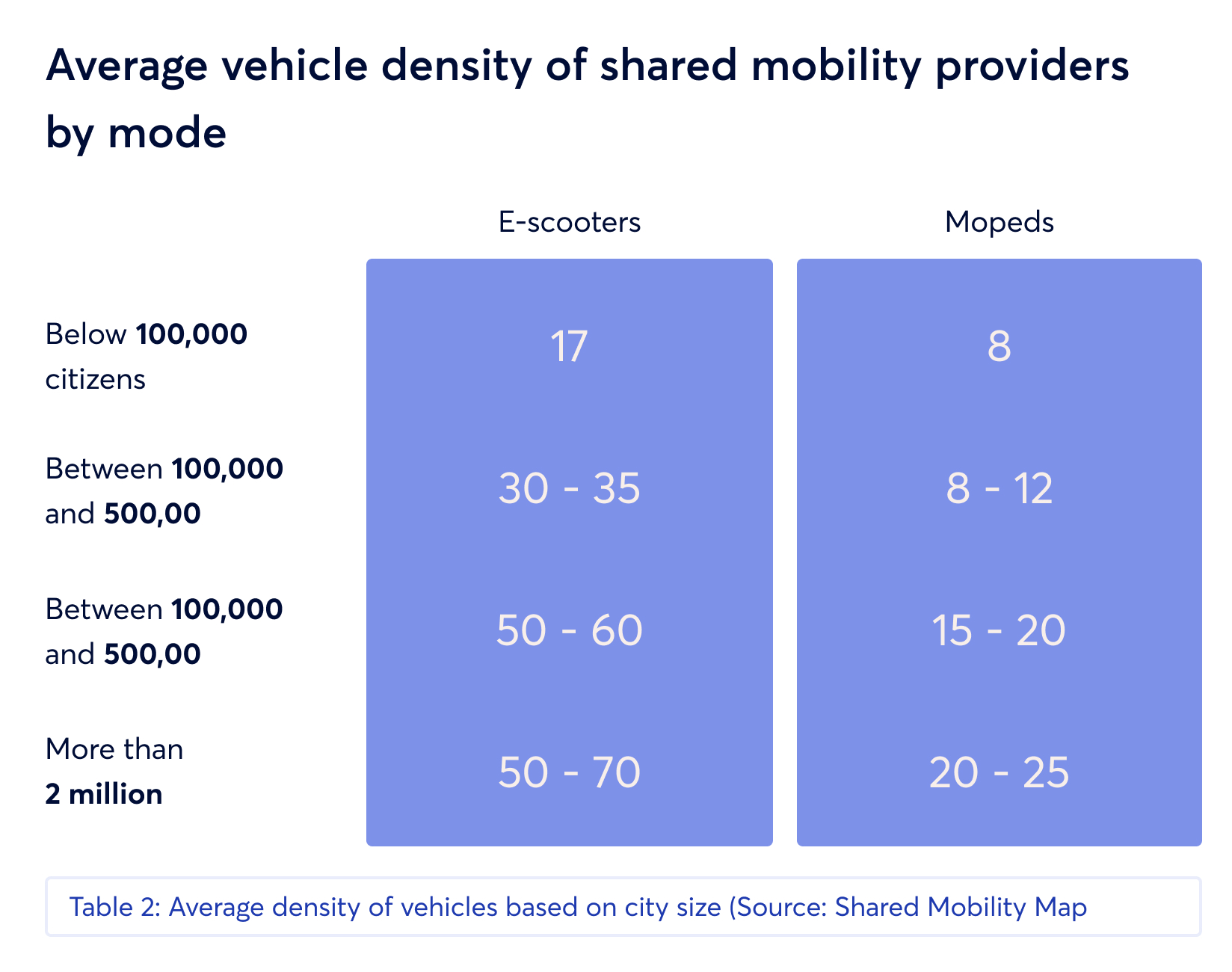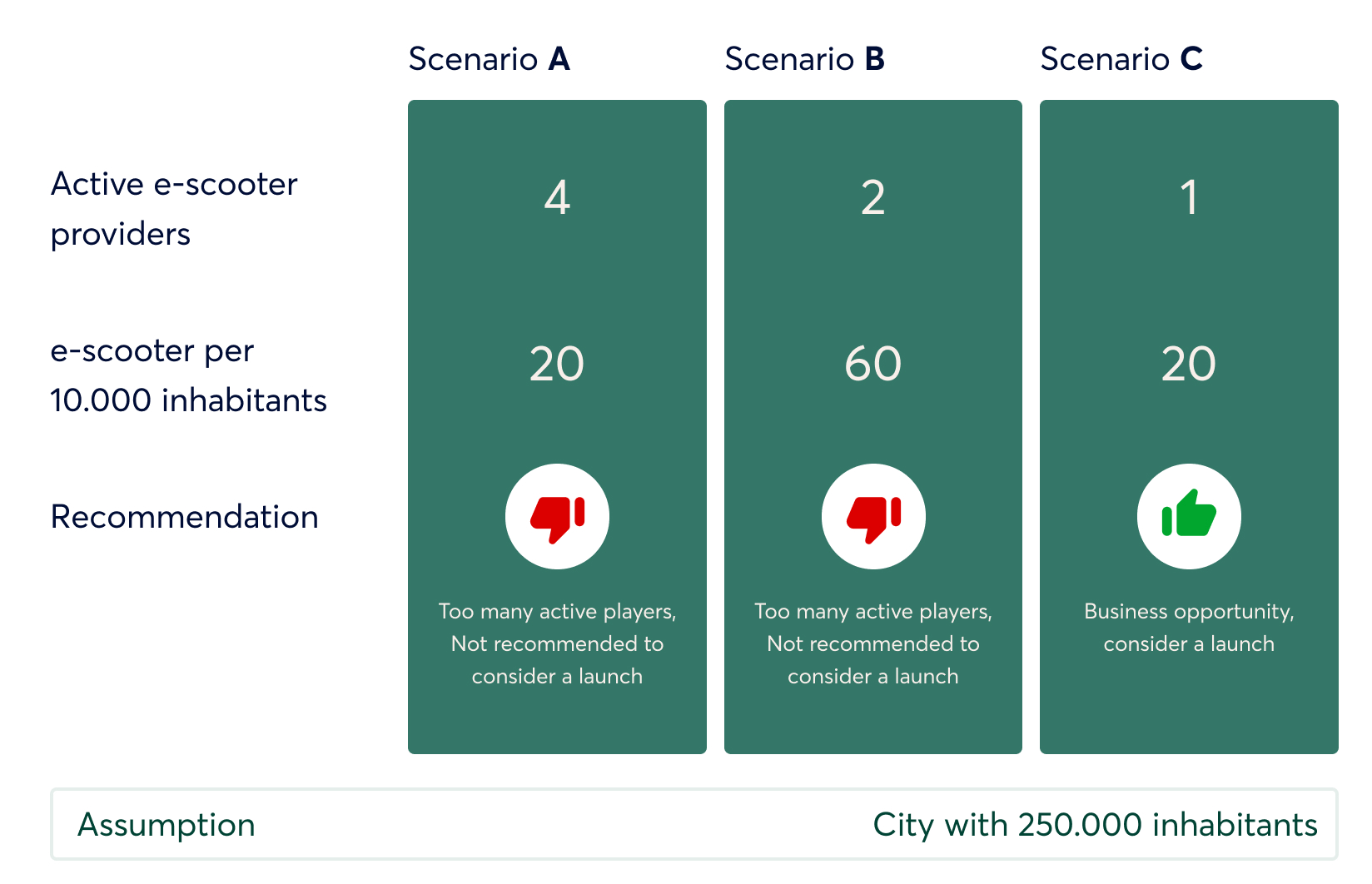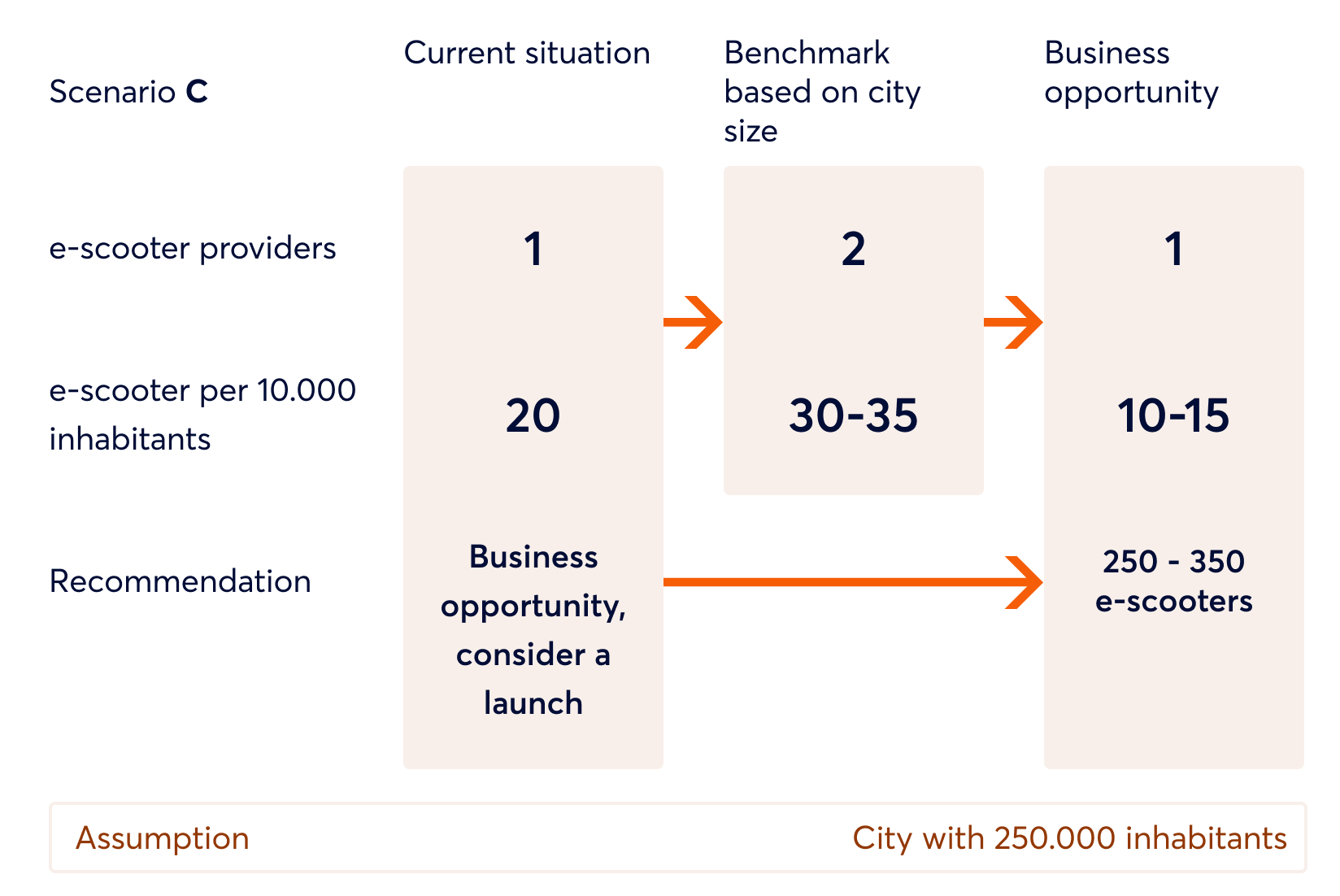Since 2018, more and more shared micro mobility operators have been expanding their services to new cities. When launching in a new market, the first questions that need to be answered are: Is there enough room for an additional player and how large should the fleet be. Here, we try to narrow down the answers to these questions by applying the insights from the Shared Micro Mobility report.
Why is it important to think about the fleet size?
Choosing the right fleet size of vehicles for a specific city is crucial for the success and the sustainability of the business. A fleet that is not large enough, will have a negative impact on the user experience and the mobility service that runs the fleet will miss out on important business opportunities. Users will not be able to find an e-scooter, bike or moped quickly enough, and so the risk of losing the customer to the competition is high. Furthermore, running a fleet that is too small can also mean that providers find it hard to have enough operational leverage to support their scaling efforts.
On the other hand, a fleet should not be too big either. If there are more vehicles on the street than there is demand, the utilization will be too low to make the business profitable. A larger fleet also means more maintenance, fleet operations and rebalancing. As shared micro mobility vehicles are often brightly colored and with big company logos, the risk of vandalism also increases, especially if the vehicles are left for too long in the same location.
Insights about fleet sizes in shared micro mobility
The vehicle density often differs by size and type of vehicles. The European Shared Mobility Index indicates that the vehicle density measured in shared vehicles per 10,000 inhabitants is higher for small vehicles like bikes or e-scooters in comparison to cars or mopeds. Of course, the budget needed to build an e-scooter or e-bike fleet is significantly lower than is needed to create a car sharing fleet.
The optimal fleet size is dependent on multiple factors
Once the fleet size for a specific city is defined, it’s important to understand that continuous monitoring of the fleet statistics is necessary in order to validate the initial decision. In some cities it might also make sense to operate with a fluctuating fleet size depending on the expected intra-day or intra-week demand for rides. The demand per weekday could differ and at a more granular level, the demand for rides can also fluctuate during a single day. Normally there are peaks in the morning and evening hours for commutes, or increased demand for lunch-time rides. Weekend demand also differs from the weekday usage patterns of shared micro mobility services.
Framework to define a fleet size
To get an indication, about whether there is enough room for an additional shared mobility player with e-scooters or mopeds in a specific city, here are some of the numbers that are available for active players.
Active shared mobility operators
The first step is to decide whether there is enough room for an additional player in the market that you’re looking at entering. With the current state of the shared micro mobility industry, where more than 150 providers are trying to grow their services across more than 450 cities in Europe, it’s nearly impossible to find an empty spot without any competition. If there is no competition, it could mean that there are strict regulations or other roadblocks in place that are avoiding a profitable business from growing there.

The above table could provide a first indication, as to whether there is room for an additional player offering shared bikes/e-bikes, e-scooters or mopeds in town. If there are already too many active vehicles, you might want to check the next entry on your shortlist of potential markets.
Existing fleet density
A second indication about whether you should enter a market or not is the fleet density per city. The average density of shared e-scooters per operator in European cities is roughly 17-20 vehicles per 10,000 inhabitants. If you multiply this by the average number of active operators per city, you could get a feeling if there is room for more scooters in the respective markets.

Only e-scooters and mopeds are listed in the table above. This is because the available data points for free floating e-bike or bike sharing schemes are limited, as bike sharing schemes are often station based in cities across Europe. The average density of e-bikes is expected to be between the average of mopeds and e-scooters. This rule of thumb could be applied to define the shared e-bike fleet per city.
Finding your opportunity
With the data above, mobility providers could evaluate if there is an opportunity for launching a shared micro mobility service with mopeds or e-scooters in a particular city or business area. The first check is to look at the active players in the respective market and the first table provides a good overview for this. With this table, you can find out if the number of active players per mode is in line with the market average per city size. If the number of active players in the market is below the indicated average, then there could be an opportunity for an additional player. If more players are already active, it might be a sign of a market with limited to no opportunities for building a sustainable business.
The second check is to look at the ratio of vehicles per 10,000 citizens. Details shared about the fleet sizes of the active players could be used to determine if there is room for additional vehicles in the different verticals. If the total density of devices is below the indicated numbers, there is a good chance for you to build a profitable business.
The graphic below visualizes the simple decision framework that can be run for every market where a launch is being considered.

The recommended fleet size for a situation as indicated in Scenario C above could be calculated by combining the benchmarks mentioned above with the current situation.
The gap between both areas is your opportunity.

A data driven approach as described here is just one of many solutions you can use for defining the fleet size per vehicle mode or city. It’s always recommended to apply other frameworks and existing knowledge as well. Shared mobility services work best in cities where the team running the service is engaged and knows a lot about the local circumstances regarding mobility options and local preferences.
Micro mobility services like shared e-scooters, bikes or mopeds are deployed in more than 600 hundred cities across Europe. The probability is thus very high that other players are already active in a city that you are consideration for a launch. It’s recommended to evaluate the competition to avoid starting with a weaker value proposition for your chosen customers. Some aspects to check could be prices, fleet size or operating area. It is recommended that you evaluate the fleet size of the competition and deploy at least as many or more vehicles in a comparable operating area as the largest player has deployed.
Defining the operating area is often a balance between vehicle density and the potential customers within the area. Having a high density of vehicles is important, as customers often value having a short walking distances to the next free vehicle. A second aspect is that a high amount of inhabitants per square kilometer is recommended to reach enough potential customers. So it’s not just defining the fleet size that is important. It’s also important to match the size of the operating area with the fleet size as this is also critical for the success of the business. The operating area of direct competitors or other shared mobility modes could provide an indication as to where to draw the lines of the business area.
Additional indicators for market attractiveness
In addition to the evaluation of the shared micro mobility competition, several other indicators could be checked as well, to get a better understanding of the market attractiveness.
Public transit
As a report by Spin has shown, an increasing share of e-scooter or shared bike rides are connected to public transit stations. Shared micro mobility and public transport could also go hand in hand in another dimension. It opens great opportunities for shared micro mobility, If the density and frequency of a public transit system are not sufficient, citizens jump on shared micro mobility devices as an alternative way to complete their journeys. So, check the performance of the public transit system in your planned markets. If the density and/or frequency of public transit is low, it could mean that there are great business opportunities for shared micro mobility services.
City regulations
Cities are playing an increasingly important role. At the beginning, when the shared micro mobility trend started to emerge, most city administrations were overwhelmed and didn’t get involved in regulating or controlling shared mobility services. This has changed and city administrations are getting more and more involved in monitoring and controlling the shared mobility space. From an operator perspective, it’s recommended to pick cities that have a neutral or positive attitude towards shared micro mobility. Cities with a supportive attitude release regulations that enable operators to build sustainable businesses. Besides that, these cities are also more likely to establish infrastructure for micro mobility, like bike lanes or dedicated parking lots for bikes, e-scooters or mopeds.
Continuous optimization
To optimize the fleet size, operating area and utilization over time, shared mobility operators of all sizes could collaborate with specialized data analytics companies like Zoba or Ubiq. These companies provide data-based tools to optimize fleet distribution and operational efficiency. A rebalancing of vehicles based on real-time and historical data could lead to a revenue increase of 20-50%. Optimizing the fleet operations management tasks like battery swapping, maintenance or rebalancing could have a huge impact on the employee performance.
For this article we teamed up with Augustin Friedel.
Augustin is a well-known shared mobility expert with passion for micro mobility, mobility on demand service and public private partnerships. After launching Uber in Germany, Augustin worked for companies like Blacklane, Rocket Internet and Deutsche Bahn subsidiary ioki. He is currently employed by Volkswagen AG but the views expressed in this article are his personal ones and do not represent any of Volkswagen’s activities or thoughts.
